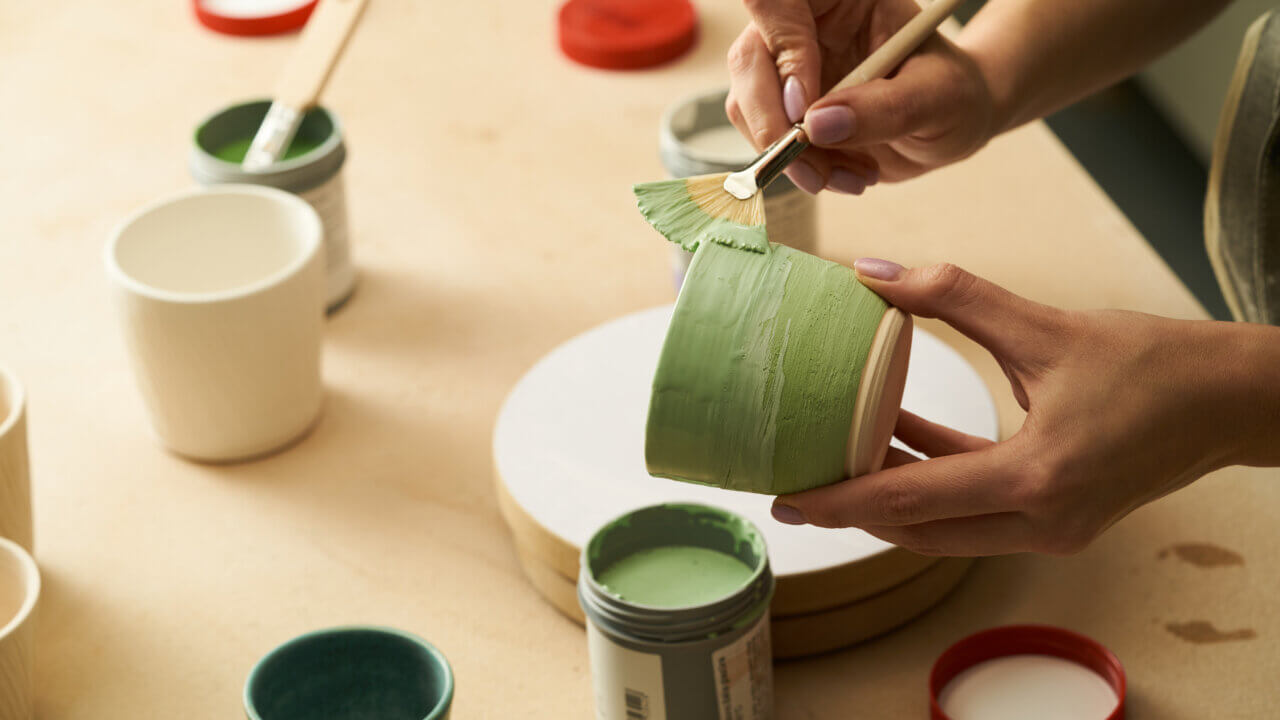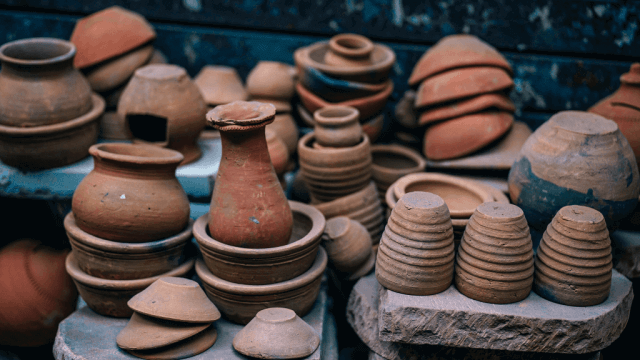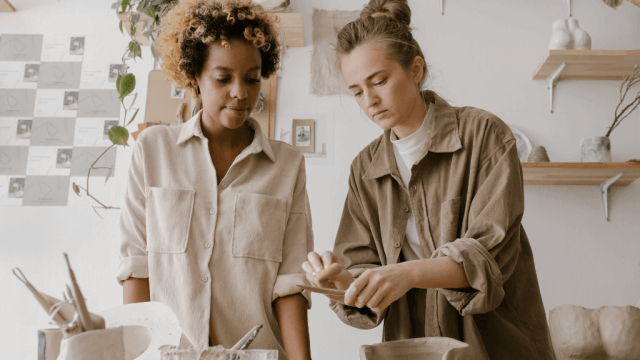To glaze pottery at home, select a suitable glaze for your clay body, ensuring compatibility and desired outcome. Clean your bisqueware to remove dust and debris. Mix the glaze to achieve a thick, smooth consistency, ensuring proper suspension of particles. Apply the glaze to your pottery with a brush, sprayer, or dipping method, aiming for even coverage. Allow the glaze to dry before stacking your pieces in a kiln, paying attention to proper placement on shelves or stilts. Fire your glazed pottery according to the temperature and schedule recommended for your specific glaze and clay, monitoring the process for safety and accuracy. Once the firing is complete, carefully cool the kiln and remove your finished glazed pottery, inspecting for any defects or issues.
Select the Right Glaze
To begin, choosing a glaze compatible with your clay body and one that will achieve the desired outcome is essential. Many premixed glazes can be purchased online or from local pottery suppliers, or you can create your own by mixing dry materials. Remember that glazes may appear different when applied to various clay bodies and fired at different temperatures.
Prepare Your Bisqueware
Before glazing, ensure your bisqueware is clean and free of dust or debris. Wipe each piece with a damp sponge, but avoid over-saturating, as excess moisture can cause glaze adhesion issues.
Proper Glaze Mixing
Mix your glaze to achieve a thick, smooth consistency similar to the texture of heavy cream. This will ensure that the particles in the glaze are evenly suspended, which is critical for a uniform application. For powdered glazes, use a designated respirator to avoid inhaling harmful dust.
Methods of Glaze Application
Glaze can be applied to pottery using various methods—each with its advantages and disadvantages. Choose the way best suits your experience, desired outcome, and available tools.
Brushing
Brushing is an accessible and precise method of applying the glaze. You can use a suitable brush loaded with glaze, brushing in overlapping bands to ensure even coverage and multiple coats may be necessary to achieve the desired thickness.
Spraying
Spraying the glaze involves using a spray gun or airbrush to apply an even layer over the pottery’s surface. This technique produces consistent coverage while minimizing the risk of glaze running during firing, but requires a well-ventilated workspace and the proper equipment.
Dipping
Dipping your pottery directly into a glaze bucket provides a fast and even application of glaze but may require more preparation and clean-up. Please ensure your glaze is well mixed to maintain particle suspension, then hold your piece with tongs, fingers, or a dipper before slowly immersing it into the glaze.
Kiln Stacking and Firing
Allow the glazed pottery to dry entirely before placing it in your kiln. Use kiln shelves or stilts to prevent the glazed pottery from touching other pieces or the kiln’s interior, as the glaze can melt and adhere during firing. Check the recommended firing temperature and schedule for your clay and glaze combination, and load the kiln accordingly. Continuously monitor the firing process for safety and accuracy.
Unloading and Inspecting Your Glazed Pottery
After the firing, allow the kiln to cool down before carefully unloading the glazed pottery. Check each piece for defects, adherence to kiln furniture, or issues related to glaze application and firing. Remember that practice and experimentation are vital to mastering the art of glazing pottery at home.
Understanding Glaze Chemistry
A basic understanding of glaze chemistry can be helpful when selecting or creating a glaze. There are four main components in a glaze: silica (glass former), flux (melting agent), alumina (stabilizer), and colorants or modifiers. Understanding the principles of glaze chemistry can help you better predict the outcome of your glaze applications and adjust recipes to your unique needs.
Protective Measures during Glazing
Always take the necessary safety precautions while working with glazes. Wearing gloves, a mask, and a respirator are essential for protecting yourself, especially when handling toxic materials or those that can become airborne. Proper ventilation is also crucial, mainly when spraying glazes or during the firing process.
Testing Glazes
I think testing your glazes before applying them to your final pieces is best. This can be done by creating small test tiles of the same clay body as your pottery and applying the glaze. Fire these test tiles with the same firing schedule you plan to use for your pottery. Test tiles will help you determine the glaze’s final color, texture, and thickness, allowing you to make necessary adjustments before committing to larger pieces.
Preventing Glaze Defects
Glaze defects such as pinholes, crazing, and crawling can often be prevented using proper glaze application techniques and understanding the compatibility between your clay body and glaze. Pinholes may result from trapped gases; ensure your bisqueware is free from organic materials and fired to the appropriate temperature before glazing. Crazing, or surface cracks in the glaze, is generally caused by poor glaze fit, which can be resolved by changing the glaze recipe or modifying the firing schedule. Crawling occurs when the glaze retracts from the pottery surface during firing; to prevent this, clean your pottery thoroughly and avoid over-saturating with water during the glaze application.
Record-Keeping and Documentation
Keeping records of your glazing process, firing schedules, and observations will help you continually refine your techniques and improve your results. Take pictures of your finished pottery and make notes about the process, the glazes used, and any modifications you made. Having a detailed record can enable you to recreate successful outcomes and prevent mistakes in the future.
FAQ Section
Here are some common questions and answers related to glazing pottery at home:
Can I use store-bought glazes, or must I make my own?
Depending on your preference, you can use both store-bought glazes and homemade glazes. Store-bought glazes are convenient and available in a wide range of colors. In contrast, homemade glazes require sourcing raw materials and knowledge of glaze chemistry but offer the possibility of creating customized formulations.
How do I know if a glaze is food safe?
A food-safe glaze should have low solubility, meaning it doesn’t leach chemicals into food or liquid. Look for glazes with a label indicating they are food-safe, lead-free, and conforming to ASTM D-4236 standards. If you are making your own glaze, consult a ceramics professional or use reputable, food-safe recipes.
What are some common mistakes to avoid when glazing?
Common glazing mistakes include insufficient cleaning of bisque ware, applying glaze too thickly or unevenly, overloading the kiln, or using an incorrect firing schedule. Clean your bisqueware thoroughly, apply the glaze evenly (using test tiles if necessary), and follow the recommended firing schedule for your specific clay and glaze combination.
Why is my glaze not adhering to the pottery?
Adhesion issues can result from several factors, including dusty bisqueware, excessive moisture in the pottery, improper glaze consistency, or a wrong glaze type for your clay body. Ensure your bisqueware is clean, avoid over-saturating, and check your glaze’s compatibility with your chosen clay.
How can I prevent glaze from sticking to the kiln shelves during firing?
Prevent glaze from sticking to kiln shelves using kiln stilts, cookies (small, flat pieces of clay), or a kiln wash to the shelves. Always leave an adequate gap between glazed pieces and the kiln shelf, and be careful not to apply glaze to the bottom of your pottery.











